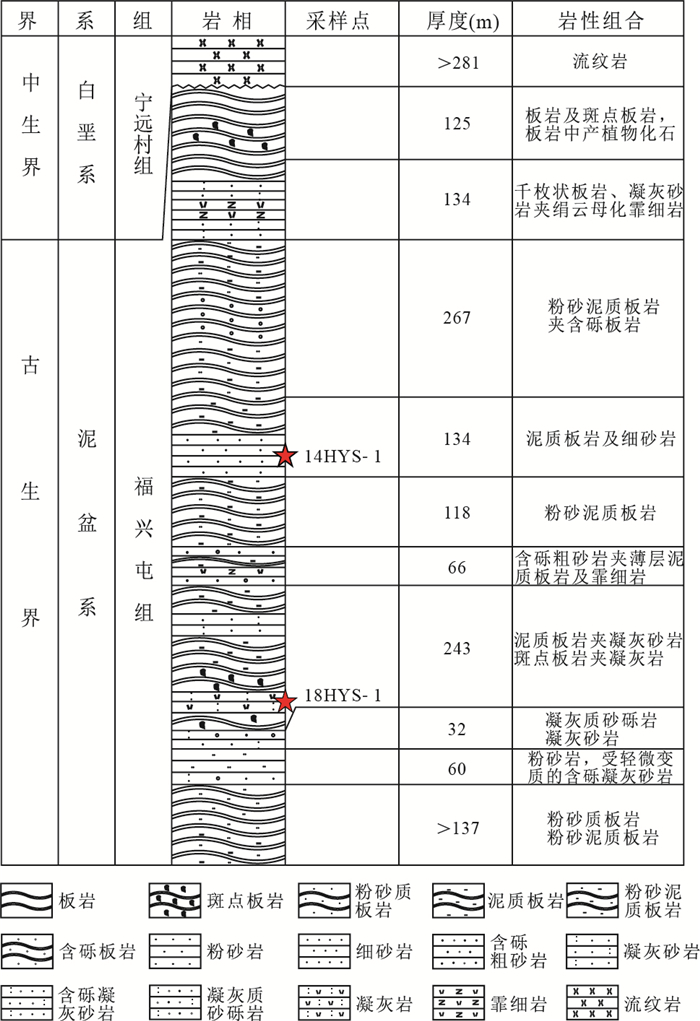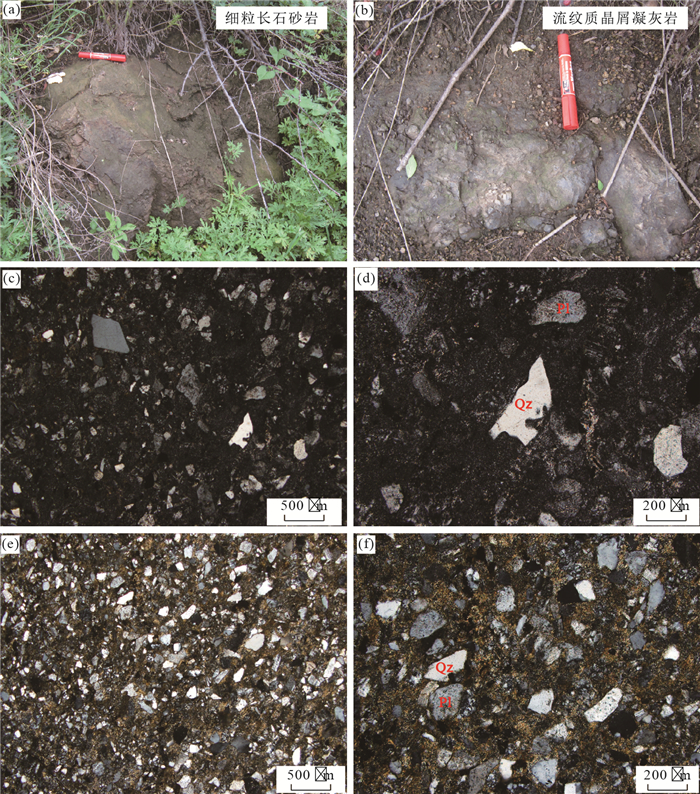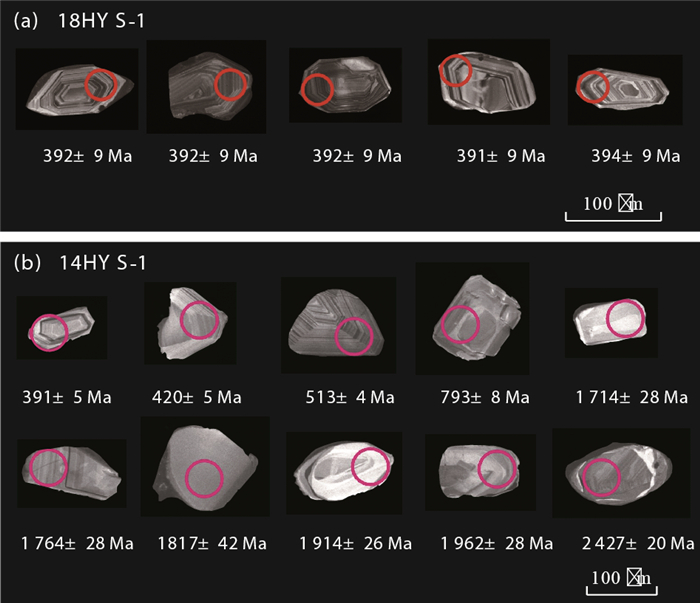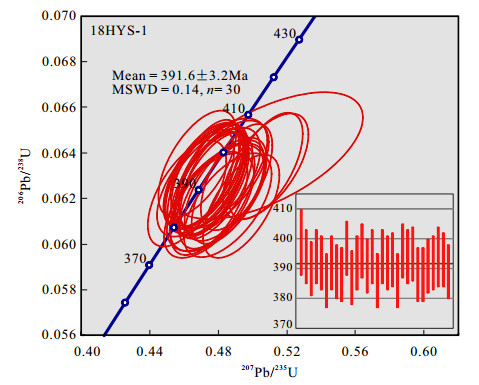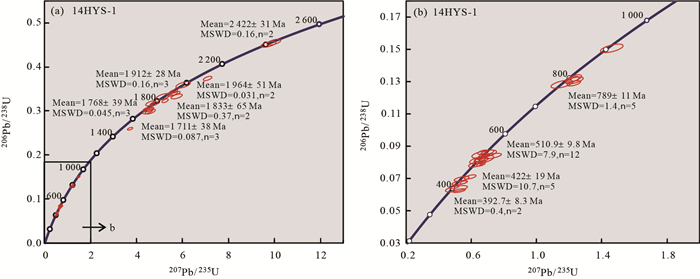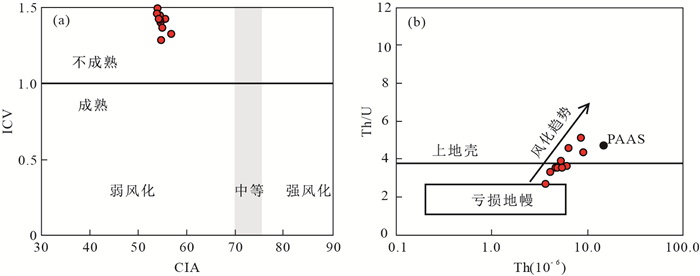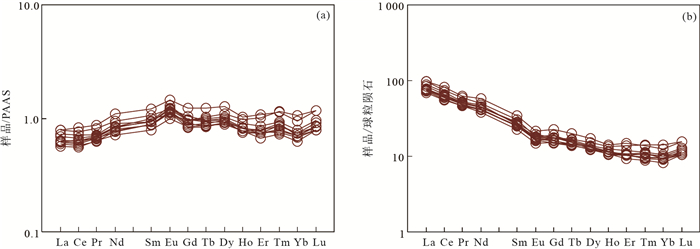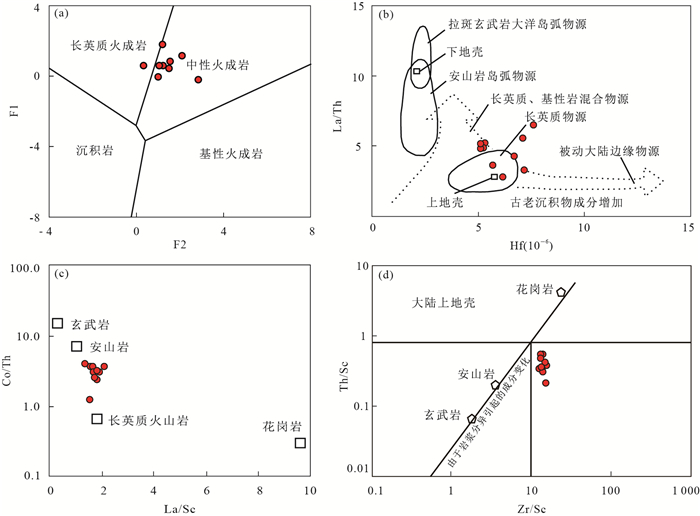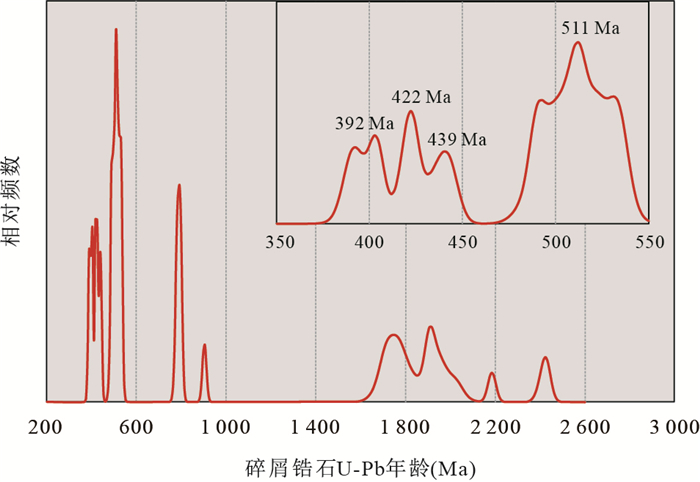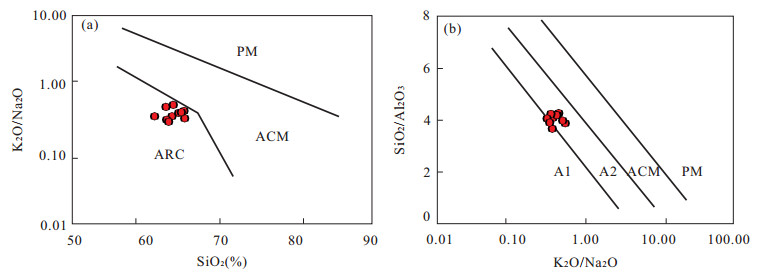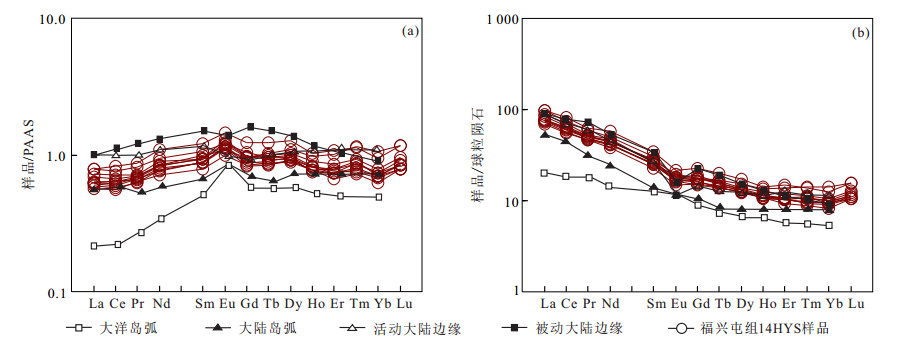Age, Provenance and Tectonic Setting of Fuxingtun Formation in Zhangguangcai Range
-
摘要: 前人对张广才岭福兴屯组研究程度较低,限制了对区域古生代构造演化的认识.福兴屯组凝灰岩锆石30个测点加权平均年龄为392±3 Ma,砂岩碎屑锆石最小一组年龄为393 Ma,指示福兴屯组形成于中泥盆世.Al2O3/TiO2平均值为19.58,稀土元素球粒陨石标准化曲线具有轻稀土富集、重稀土稳定和负Eu异常特征,结合碎屑锆石年龄峰值,确定福兴屯组物源主要为晚古生代中酸性火成岩和早古生代花岗质岩.地球化学和区域火山岩特征共同揭示福兴屯组形成于伸展构造环境.松嫩-张广才岭地块和佳木斯地块晚古生代早期地层均广泛分布有489~551 Ma的碎屑锆石,暗示两地块在福兴屯组沉积之前已完成拼合,为两地块于早古生代晚期拼合提供了新的证据.Abstract: Previous studies on the Fuxingtun Formation in Zhangguangcai Range are relatively inadequate, which has limited the understanding of regional Paleozoic tectonic evolution. The weighted average age of zircons from tuff of 30 test points in the Fuxingtun Formation is 392±3 Ma, and the minimum age of detrital zircons from arkose is 393 Ma, indicating that the Fuxingtun Formation was formed in the Middle Devonian. Al2O3/TiO2 average value is 19.58, and chondrite-normalized REE patterns have the characteristics of enrichment in light rare earth, stability in heavy rare earth and negative Eu anomaly, which, combined with detrital zircons age populations, indicates that the provenance of the Fuxingtun Formation was mainly derived from the Late Paleozoic intermediate-acid igneous rocks and the Early Paleozoic granitic rocks. The geochemical and regional volcanic characteristics reveal that the Fuxingtun Formation was formed in extensional environment. 489-551 Ma detrital zircons are widely distributed in the Late Paleozoic early strata in Songnen-Zhangguangcai Range massif and Jiamusi massif, suggesting that the two blocks had been combined before the deposition of the Fuxingtun Formation, which provides a new evidence for the combination of the two blocks in the late Early Paleozoic.
-
Key words:
- Zhangguangcai Range /
- Fuxingtun Formation /
- U-Pb chronology /
- geochemistry /
- provenance /
- tectonic setting /
- petrology
-
表 1 福兴屯组沉积岩主量(%)和微量元素(10-6)分析结果
Table 1. Major and trace element compositions of the sedimentary rocks from the Fuxingtun Formation
样品号 14HYS-1-1 14HYS-1-2 14HYS-1-3 14HYS-1-4 14HYS-1-5 14HYS-1-6 14HYS-1-7 14HYS-1-8 14HYS-1-9 14HYS-1-10 Fe2O3 2.91 1.66 2.56 2.53 0.85 2.59 1.74 3.41 2.46 2.06 FeO 2.80 4.15 3.18 3.47 4.92 4.18 4.31 3.18 4.38 4.43 TFe2O3 6.02 6.27 6.09 6.39 6.32 7.23 6.53 6.94 7.33 6.98 MnO 0.12 0.12 0.11 0.10 0.10 0.13 0.11 0.12 0.13 0.20 TiO2 0.70 0.86 0.79 0.74 0.74 0.81 0.76 0.70 0.84 1.32 CaO 1.86 1.70 1.47 1.74 1.58 1.51 1.55 1.74 1.64 1.67 K2O 1.87 2.04 1.66 1.73 2.53 1.95 1.96 1.47 2.18 1.56 P2O5 0.22 0.22 0.22 0.21 0.19 0.21 0.22 0.22 0.23 0.29 SiO2 64.22 64.94 65.04 63.38 63.53 61.02 64.56 62.66 62.56 62.90 Al2O3 15.33 15.18 15.28 15.48 16.28 16.52 15.33 16.04 15.74 15.49 MgO 2.36 2.66 2.17 2.51 2.28 2.82 2.51 2.29 2.77 2.66 Na2O 4.64 4.73 4.96 4.84 4.82 5.49 4.80 4.58 4.45 5.18 LOI 2.86 1.60 2.36 2.34 1.35 2.28 1.64 3.06 2.05 1.78 Total 99.89 99.86 99.80 99.07 99.16 99.51 99.49 99.47 99.43 99.54 Al2O3/TiO2 21.90 17.65 19.34 20.92 22.00 20.40 20.17 22.91 18.74 11.73 CIA 54.04 53.72 54.75 54.36 54.59 54.33 54.43 56.62 55.42 53.90 ICV 1.43 1.46 1.37 1.42 1.29 1.45 1.40 1.33 1.43 1.50 PIA 54.71 54.40 55.45 55.02 55.63 55.03 55.21 57.46 56.50 54.42 Sc 13.20 14.30 13.50 13.40 15.60 16.40 14.00 14.20 14.20 17.30 V 108.00 117.00 108.00 112.00 102.00 128.00 117.00 116.00 125.00 149.00 Cr 77.40 106.00 87.40 80.00 53.60 95.60 86.60 86.10 106.00 185.00 Co 16.30 16.20 15.00 16.80 10.70 21.70 15.10 19.60 19.90 14.60 Ni 33.30 37.70 32.40 40.40 27.60 46.60 41.20 40.10 41.10 39.10 Rb 41.10 50.60 32.20 35.50 74.20 52.70 39.70 37.00 46.60 31.20 Sr 244.00 246.00 226.00 259.00 198.00 290.00 245.00 268.00 251.00 204.00 Y 20.30 23.10 18.90 20.90 27.50 29.20 19.50 23.60 22.00 21.30 Zr 171.00 189.00 187.00 167.00 203.00 228.00 190.00 209.00 216.00 260.00 Hf 5.69 5.32 5.12 5.12 6.16 7.19 5.27 6.68 7.12 7.60 Th 6.36 5.24 4.11 4.64 8.54 9.04 4.85 6.05 5.40 3.66 U 1.37 1.33 1.22 1.30 1.65 2.05 1.36 1.63 1.51 1.59 Th/U 4.64 3.94 3.37 3.57 5.18 4.41 3.57 3.71 3.58 2.30 Rb/Sr 0.17 0.21 0.14 0.14 0.37 0.18 0.16 0.14 0.19 0.15 La 23.30 27.60 21.40 22.60 24.30 30.10 23.70 26.10 30.10 23.90 Ce 47.50 57.20 44.80 45.80 50.80 66.40 51.30 53.20 60.70 48.90 Pr 5.99 6.35 5.62 5.61 6.18 7.68 5.83 6.30 7.30 6.07 Nd 24.50 28.70 22.80 24.90 26.80 34.90 25.50 27.10 30.20 26.60 Sm 4.94 5.19 4.40 4.97 5.57 6.81 4.91 5.21 5.96 5.33 Eu 1.25 1.35 1.09 1.26 1.18 1.60 1.22 1.31 1.34 1.43 Gd 4.11 4.57 3.96 4.24 4.53 5.81 3.90 4.52 4.93 4.56 Tb 0.69 0.72 0.67 0.66 0.79 0.94 0.65 0.77 0.74 0.74 Dy 4.26 4.07 3.89 4.02 4.86 5.62 4.00 4.50 4.21 4.34 Ho 0.75 0.82 0.77 0.78 0.97 1.03 0.77 0.90 0.81 0.83 Er 2.15 2.15 1.94 2.27 2.91 3.13 2.14 2.48 2.28 2.20 Tm 0.35 0.32 0.29 0.36 0.46 0.45 0.31 0.37 0.34 0.30 Yb 2.08 1.97 1.74 1.96 2.97 2.65 1.97 2.22 2.08 1.90 Lu 0.36 0.37 0.34 0.36 0.50 0.50 0.34 0.41 0.39 0.34 ∑REE 122.23 141.38 113.71 119.79 132.82 167.62 126.54 135.39 151.38 127.44 ∑LREE 107.48 126.39 100.11 105.14 114.83 147.49 112.46 119.22 135.60 112.23 ∑HREE 14.75 14.99 13.60 14.65 17.99 20.13 14.08 16.17 15.78 15.21 L/H 7.29 8.43 7.36 7.18 6.38 7.33 7.99 7.37 8.59 7.38 La/Yb 11.20 14.01 12.30 11.53 8.18 11.36 12.03 11.76 14.47 12.58 (La/Yb)N 7.55 9.45 8.29 7.77 5.52 7.66 8.11 7.93 9.76 8.48 (Gd/Yb)N 1.59 1.87 1.84 1.75 1.23 1.77 1.60 1.64 1.91 1.94 δEu 0.83 0.83 0.78 0.82 0.70 0.76 0.83 0.81 0.74 0.87 δCe 0.95 1.00 0.96 0.95 0.97 1.03 1.02 0.97 0.96 0.95 注:TFe2O3=Fe2O3+1.111FeO;化学蚀变指数(CIA)=[Al2O3/(Al2O3+CaO*+Na2O+K2O)]×100,成分变异指数(ICV)=(Fe2O3+K2O+Na2O+CaO*+MgO+MnO+TiO2)/Al2O3,斜长石风化程度指数(PIA)=[(Al2O3-K2O)/(Al2O3+CaO*+Na2O-K2O)]×100,以上式子中的主要成分指摩尔分数,CaO*为碳酸盐中的CaO,即全岩中的CaO扣除掉化学沉积的CaO的摩尔分数(McLennan,1993);∑REE不包括Sc和Y元素;L/H=∑LREE/∑HREE;N代表球粒陨石标准化值;δEu=2Eu N/(Sm N / Gd N);δCe=2Ce N/(La N /Pr N). 表 2 福兴屯组沉积岩与不同构造背景砂岩稀土元素特征比较
Table 2. Geochemical comparison between sedimentary rocks from the Fuxingtun Formation and sandstones from various tectonic settings
构造背景 La(10-6) Ce(10-6) ∑REE(10-6) La/Yb (La/Yb)N L/H δEu 大洋岛弧 8.00±1.70 19.00±3.70 58.00±10.00 4.20±1.30 2.80±0.90 3.80±0.90 1.04±0.11 大陆岛弧 27.00±4.50 59.00±8.20 146.00±20.00 11.00±3.60 7.50±2.50 7.70±1.70 0.79±0.13 活动大陆边缘 37.00 78.00 186.00 12.50 8.50 9.10 0.60 被动大陆边缘 39.00 85.00 210.00 15.90 10.80 8.50 0.56 样品(平均值) 25.31 52.66 133.83 11.94 8.05 7.53 0.80 注:大洋岛弧、大陆岛弧、活动大陆边缘和被动大陆边缘数据据Bhatia(1985). -
Andersen, T., 2002. Correction of Common Lead in U-Pb Analyses That do not Report 204Pb. Chemical Geology, 192(1-2): 59-79. https://doi.org/10.1016/s0009-2541(02)00195-x Bai, J.K., Chen, J.L., Zhu, X.H., et al., 2018.Provenance Characteristics of Kalamaili Formation in Northeastern Margin of Junggar Basin:Constraints of Geochemistry and Detrital Zircon U-Pb Geochronology. Earth Science, 43(12):4411-4426(in Chinese with English abstract). http://d.old.wanfangdata.com.cn/Periodical/dqkx201812012 Bhatia, M. R., 1985. Rare Earth Element Geochemistry of Australian Paleozoic Graywackes and Mudrocks: Provenance and Tectonic Control. Sedimentary Geology, 45(1-2): 97-113. https://doi.org/10.1016/0037-0738(85)90025-9 Bi, J. H., Ge, W. C., Yang, H., et al., 2014. Petrogenesis and Tectonic Implications of Early Paleozoic Granitic Magmatism in the Jiamusi Massif, NE China: Geochronological, Geochemical and Hf Isotopic Evidence. Journal of Asian Earth Sciences, 96: 308-331. https://doi.org/10.1016/j.jseaes.2014.09.013 Cox, R., Lowe, D. R., Cullers, R. L., 1995. The Influence of Sediment Recycling and Basement Composition on Evolution of Mudrock Chemistry in the Southwestern United States. Geochimica et Cosmochimica Acta, 59(14): 2919-2940. https://doi.org/10.1016/0016-7037(95)00185-9 Fedo, C. M., Wayne Nesbitt, H., Young, G. M., 1995. Unraveling the Effects of Potassium Metasomatism in Sedimentary Rocks and Paleosols, with Implications for Paleoweathering Conditions and Provenance. Geology, 23(10): 921. https://doi.org/10.1130/0091-7613(1995)0230921:uteopm > 2.3.co; 2 doi: 10.1130/0091-7613(1995)0230921:uteopm>2.3.co;2 Gao, F.H., Wang, F., Xu, W.L., et al., 2013. Age of the "Paleoproterozoic" Dongfengshan Group in the Lesser Xing'an Range, NE China, and Its Tectonic Implications: Constraints from Zircon U-Pb Geochronology. Journal of Jilin University(Earth Science Edition), 43(2): 440-456(in Chinese with English abstract). Girty, G.H., Ridge, D.L., Knaack, C., et al., 1996. Provenance and Depositional Setting of Paleozoic Chert and Argillite, Sierra Nevada, California. SEPM Journal of Sedimentary Research, 66(1): 107-118. https://doi.org/10.1306/d42682ca-2b26-11d7-8648000102c1865d Guo, P., Xu, W. L., Wang, Z. W., et al., 2018. Geochronology and Geochemistry of Late Devonian-Carboniferous Igneous Rocks in the Songnen-Zhangguangcai Range Massif, NE China: Constraints on the Late Paleozoic Tectonic Evolution of the Eastern Central Asian Orogenic Belt. Gondwana Research, 57: 119-132. https://doi.org/10.1016/j.gr.2018.01.007 Hao, W.L., Xu, W.L., Wang, F., et al., 2014. Geochronology of the "Neoproterozoic" Yimianpo Group in the Zhangguangcai Range, NE China: Constraints from U-Pb Ages of Detrial and Magmatic Zircons. Acta Petrologica Sinica, 30(7): 1867-1878(in Chinese with English abstract). Hayashi, K. I., Fujisawa, H., Holland, H. D., et al., 1997. Geochemistry of ~1.9 Ga Sedimentary Rocks from Northeastern Labrador, Canada. Geochimica et Cosmochimica Acta, 61(19): 4115-4137. https://doi.org/10.1016/s0016-7037(97)00214-7 Heilongjiang Bureau of Geology and Mineral Resource, 2008.Lithostratigraphy of Heilongjiang Province. China University of Geosciences Press, Wuhan, 298(in Chinese). Li, J.Y., Zhang, J., Yang, T.N., et al., 2009.Crustal Tectonic Division and Evolution of the Southern Part of the North Asian Orogenic Region and Its Adjacent Areas. Journal of Jilin University(Earth Science Edition), 39(4):584-605(in Chinese with English abstract). http://www.wanfangdata.com.cn/details/detail.do?_type=perio&id=cckjdxxb200904002 Liu, Y. S., Hu, Z. C., Gao, S., et al., 2008. In Situ Analysis of Major and Trace Elements of Anhydrous Minerals by LA-ICP-MS without Applying an Internal Standard. Chemical Geology, 257(1-2): 34-43. https://doi.org/10.1016/j.chemgeo.2008.08.004 Ludwig, K.R., 2012.ISOPLOT 3.75: A Geochronological Toolkit for Microsoft Excel. Geochronology Centre Special Publication, Berkeley, 75. McLennan, S.M., 1993. Weathering and Global Denudation. The Journal of Geology, 101(2): 295-303. https://doi.org/10.1086/648222 Meng, E., Xu, W.L., Pei, F.P., et al., 2010. Detrital-Zircon Geochronology of Late Paleozoic Sedimentary Rocks in Eastern Heilongjiang Province, NE China: Implications for the Tectonic Evolution of the Eastern Segment of the Central Asian Orogenic Belt. Tectonophysics, 485(1-4): 42-51. https://doi.org/10.1016/j.tecto.2009.11.015 Meng, E., Xu, W.L., Pei, F.P., et al., 2011. Middle Devonian Volcanism in Eastern Heilongjiang Province and Its Tectonic Implications: Constraints from Petro-Geochemistry, Zircon U-Pb Chronology and Sr-Nd-Hf Isotopes. Acta Petrologica et Mineralogica, 30(5): 883-900(in Chinese with English abstract). http://d.wanfangdata.com.cn/Periodical/yskwxzz201105012 Nesbitt, H. W., Young, G. M., 1982. Early Proterozoic Climates and Plate Motions Inferred from Major Element Chemistry of Lutites. Nature, 299(5885): 715-717. https://doi.org/10.1038/299715a0 Şengör, A. M. C., Natal'in, B. A., Burtman, V. S., 1993. Evolution of the Altaid Tectonic Collage and Palaeozoic Crustal Growth in Eurasia. Nature, 364(6435): 299-307. https://doi.org/10.1038/364299a0 Sun, S. S., McDonough, W. F., 1989. Chemical and Isotopic Systematics of Oceanic Basalts: Implications for Mantle Composition and Processes. Geological Society, London, Special Publications, 42(1): 313-345. https://doi.org/10.1144/gsl.sp.1989.042.01.19 Wang, F., Xu, W. L., Gao, F. H., et al., 2014. Precambrian Terrane within the Songnen-Zhangguangcai Range Massif, NE China: Evidence from U-Pb Ages of Detrital Zircons from the Dongfengshan and Tadong Groups. Gondwana Research, 26(1): 402-413. https://doi.org/10.1016/j.gr.2013.06.017 Wang, F., Xu, W. L., Gao, F. H., et al., 2012a. Tectonic History of the Zhangguangcailing Group in Eastern Heilongjiang Province, NE China: Constraints from U-Pb Geochronology of Detrital and Magmatic Zircons. Tectonophysics, 566-567. https://doi.org/10.1016/j.tecto.2012.07.018 Wang, F., Xu, W. L., Meng, E., et al., 2012b. Early Paleozoic Amalgamation of the Songnen-Zhangguangcai Range and Jiamusi Massifs in the Eastern Segment of the Central Asian Orogenic Belt: Geochronological and Geochemical Evidence from Granitoids and Rhyolites. Journal of Asian Earth Sciences, 49: 234-248. https://doi.org/10.1016/j.jseaes.2011.09.022 Wang, Q.Y., Mou, C.L., He, J., et al., 2018. Provenance Analysis and Tectonic Setting Judgment in Shanglan Formation of Middle Triassic in Weixi Area. Earth Science, 43(8): 2811-2832(in Chinese with English abstract). http://d.old.wanfangdata.com.cn/Periodical/dqkx201808020 Wang, Z. W., Xu, W. L., Pei, F. P., et al., 2016. Geochronology and Geochemistry of Early Paleozoic Igneous Rocks of the Lesser Xing'an Range, NE China: Implications for the Tectonic Evolution of the Eastern Central Asian Orogenic Belt. Lithos, 261: 144-163. https://doi.org/10.1016/j.lithos.2015.11.006 Wang, Z. W., Xu, W. L., Pei, F. P., et al., 2017. Geochronology and Geochemistry of Early Paleozoic Igneous Rocks from the Zhangguangcai Range, Northeastern China: Constraints on Tectonic Evolution of the Eastern Central Asian Orogenic Belt. Lithosphere, 9(5): 803-827. https://doi.org/10.1130/l639.1 Wilde, S., 2003. Late Pan-African Magmatism in Northeastern China: SHRIMP U-Pb Zircon Evidence from Granitoids in the Jiamusi Massif. Precambrian Research, 122(1-4): 311-327. https://doi.org/10.1016/s0301-9268(02)00217-6 Wu, F. Y., Sun, D. Y., Ge, W. C., et al., 2011. Geochronology of the Phanerozoic Granitoids in Northeastern China. Journal of Asian Earth Sciences, 41(1): 1-30. https://doi.org/10.1016/j.jseaes.2010.11.014 Xu, M. J., Xu, W. L., Wang, F., et al., 2012. Age, Association and Provenance of the "Neoproterozoic" Fengshuigouhe Group in the Northwestern Lesser Xing'an Range, NE China: Constraints from Zircon U-Pb Geochronology. Journal of Earth Science, 23(6): 786-801. https://doi.org/10.1007/s12583-012-0291-0 Xu, ,W.L., Wang, ,F., Meng, ,E., et al., 2012.Paleozoic- Early Mesozoic Tectonic Evolution in Eastern Heilongjiang Province, NE China:Evidence from Igneous Rock Association and U-Pb Geochronology of Detrital Zircons.Journal of Jilin University(Earth Science Edition), 42(5):1378-1389(in Chinese with English abstract). Yu, J. J., Wang, F., Xu, W. L., et al., 2013. Late Permian Tectonic Evolution at the Southeastern Margin of the Songnen-Zhangguangcai Range Massif, NE China: Constraints from Geochronology and Geochemistry of Granitoids. Gondwana Research, 24(2): 635-647. https://doi.org/10.1016/j.gr.2012.11.015 Yuan, H. L., Gao, S., Liu, X. M., et al., 2004. Accurate U-Pb Age and Trace Element Determinations of Zircon by Laser Ablation-Inductively Coupled Plasma-Mass Spectrometry. Geostandards and Geoanalytical Research, 28(3): 353-370. https://doi.org/10.1111/j.1751-908x.2004.tb00755.x Zhou, J. B., Wilde, S. A., Zhang, X. Z., et al., 2009. The Onset of Pacific Margin Accretion in NE China: Evidence from the Heilongjiang High-Pressure Metamorphic Belt. Tectonophysics, 478(3-4): 230-246. https://doi.org/10.1016/j.tecto.2009.08.009 Zhou, J. B., Wilde, S. A., Zhang, X. Z., et al., 2011. A > 1 300 km Late Pan-African Metamorphic Belt in NE China: New Evidence from the Xing'an Block and Its Tectonic Implications. Tectonophysics, 509(3-4): 280-292. https://doi.org/10.1016/j.tecto.2011.06.018 Zhou, J. B., Wilde, S. A., Zhao, G. C., et al., 2010a. Was the Easternmost Segment of the Central Asian Orogenic Belt Derived from Gondwana or Siberia: An Intriguing Dilemma?. Journal of Geodynamics, 50(3-4): 300-317. https://doi.org/10.1016/j.jog.2010.02.004 Zhou, J. B., Wilde, S. A., Zhao, G. C., et al., 2010b. Pan-African Metamorphic and Magmatic Rocks of the Khanka Massif, NE China: Further Evidence Regarding Their Affinity. Geological Magazine, 147(5): 737-749. doi: 10.1017/S0016756810000063 Zhu, C. Y., Zhao, G. C., Sun, M., et al., 2017. Geochronology and Geochemistry of the Yilan Greenschists and Amphibolites in the Heilongjiang Complex, Northeastern China and Tectonic Implications. Gondwana Research, 43: 213-228. https://doi.org/10.1016/j.gr.2016.02.001 白建科, 陈隽璐, 朱小辉, 等, 2018.准噶尔盆地东北缘卡拉麦里组物源区特征:碎屑岩地球化学及锆石U-Pb年代学的制约.地球科学, 43(12):4411-4426. doi: 10.3799/dqkx.2018.587 高福红, 王枫, 许文良, 等, 2013.小兴安岭"古元古代"东风山群的形成时代及其构造意义:锆石U-Pb年代学证据.吉林大学学报(地球科学版), 43(2): 440-456. 郝文丽, 许文良, 王枫, 等, 2014.张广才岭"新元古代"一面坡群的形成时代:来自岩浆锆石和碎屑锆石U-Pb年龄的制约.岩石学报, 30(7): 1867-1878. 黑龙江省地质矿产局, 2008.黑龙江省岩石地层.武汉:中国地质大学出版社, 298. 李锦轶, 张进, 杨天南, 等, 2009.北亚造山区南部及其毗邻地区地壳构造分区与构造演化.吉林大学学报(地球科学版), 39(4):584-605. http://d.old.wanfangdata.com.cn/Periodical/cckjdxxb200904002 孟恩, 许文良, 裴福萍, 等, 2011.黑龙江省东部中泥盆世火山作用及其构造意义:来自岩石地球化学、锆石U-Pb年代学和Sr-Nd-Hf同位素的制约.岩石矿物学杂志, 30(5): 883-900. doi: 10.3969/j.issn.1000-6524.2011.05.012 王启宇, 牟传龙, 贺娟, 等, 2018.维西地区中三叠统上兰组物源分析及构造背景判断.地球科学, 43(8): 2811-2832. doi: 10.3799/dqkx.2018.307 许文良, 王枫, 孟恩, 等, 2012.黑龙江省东部古生代-早中生代的构造演化:火成岩组合与碎屑锆石U-Pb年代学证据.吉林大学学报(地球科学版), 42(5):1378-1389. -
 dqkx-44-10-3223-TableS1.pdf
dqkx-44-10-3223-TableS1.pdf

-









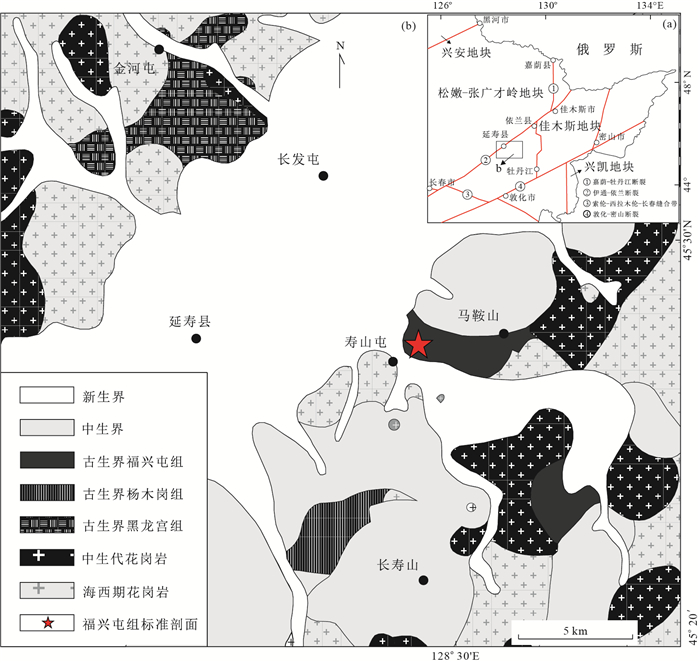
 下载:
下载:
